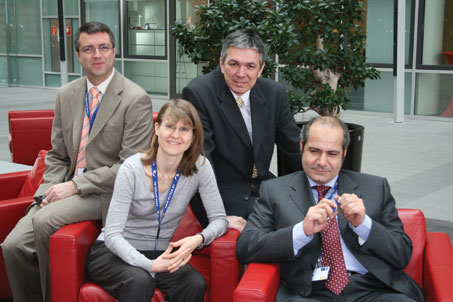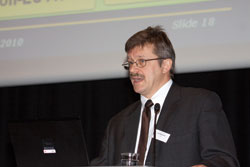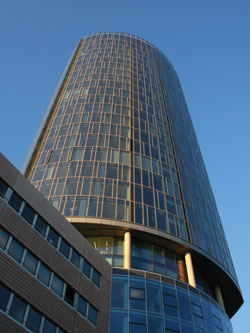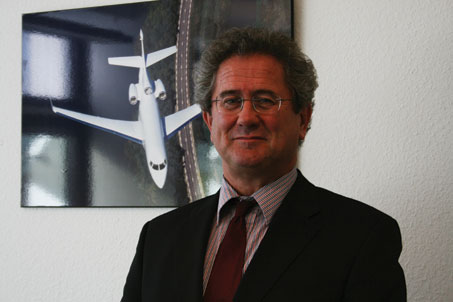
The team of R.5.2, Airport Section inside the Rulemaking Directorate of EASA: Velissarios Eleftheriou, Sarah Poralla, Predrag Sekulic and Emmanouil Vardakis.
The Team
The department for ATM and airports (R.5) is part of the EASA Rulemaking directorate. The directorate is headed by Mr. Jules Kneepkens, former head of the Belgian Civil Aviation Authority. The department is led by Mr. Jussi Myllarniemi, a Finnish national with extensive experience in ATM. Jussi was also his country’s transport attaché to the Council of Ministers in Brussels at the time of the Single European Sky I package. The department, that is still growing, is divided in two sections: section R.5.1 is dealing with the development of the implementing measures for the safety regulation of Air Traffic Management and Air Navigation Services, while section R.5.2 is concentrating on those for aerodrome safety. The composition of the team reflects a mix between regulatory experience obtained at Member State or EU level and practical airport operational experience.

The Task
The main task of the department is to transpose the ICAO Annex 14 on Aerodrome Design and Operations and its related documents into a comprehensive body of common European rules and certification specifications. This spring the team will start the work on three defined rulemaking tasks that deal with:
1. Authority and organisation requirements,
2. Aerodrome operations, and
3. Aerodrome design.
EASA’s rulemaking procedure foresees a close collaboration on the draft rules with a group of experts from industry and the national aviation authorities. This is followed by extensive consultation with the wider public before EASA submits its opinion to the European Commission in the summer/autumn of 2012.

Head of Department for ATM and Airports, R.5, Jussi Myllarniemi.
Apart from helping its Member States to fulfil their obligations towards ICAO, by developing a common framework for aerodrome safety certification as well as the design and operational requirements that need to underpin it, EASA also has the opportunity to fill in details in areas where the ICAO SARPs remain silent or are not detailed enough. The conditions for the use of new technologies may thus be introduced and a common, proportionate concept of aerodrome SMS can be developed.
Runway incursions
 One such area that EASA will give high importance is that of runway incursions: A runway incursion is defined as “any occurrence at an aerodrome involving the incorrect presence of an aircraft, vehicle or person on the protected area of a surface designated for the landing and take off of aircraft”.
One such area that EASA will give high importance is that of runway incursions: A runway incursion is defined as “any occurrence at an aerodrome involving the incorrect presence of an aircraft, vehicle or person on the protected area of a surface designated for the landing and take off of aircraft”.
Runway incursions have so far led to deadly aviation accidents around the world; they have therefore been associated with unacceptable safety risks which have to be mitigated. Factors such as complex aerodrome design, lack of or non standard visual aids, low visibility conditions, pilot or ATC workload, use of non standard phraseology, lack of training or situational awareness, etc, are just few of the factors that can contribute to a runway incursion. In the USA, safety recommendations related to runway incursions are amongst the “most wanted” transportation safety improvements, while awareness campaigns have been launched by several aviation authorities around the world.
In Europe, a joint effort of the aviation community to impact runway incursions led to the adoption of the European Action Plan for the Prevention of Runway Incursions (EAPPRI) in the early beginning of the previous decade under the coordination of EUROCONTROL. The EAPPRI has been continuously worked on with all stakeholders and an update is about to be published. It contains several groups of recommendations addressed to the key players of the aviation system (aircraft operators, aerodrome operators, Air Navigation Service Providers, national aviation authorities etc), whose implementation has been identified as contributing to the prevention of runway incursions.

EASA Rulemaking Director Jules Kneepkens.
However, until today the EAPPRI has remained a useful yet non-mandatory collection of recommendations. According to EASA’s analysis, almost 65% of them are addressed to airport operators and ANSPs. Given its mandate to develop implementing measures for the safety of both aerodromes and ATM/ANS, EASA has now the chance to review these recommendations carefully and build them into the draft future rules in both areas. This would be a major milestone and constitute a practical example of how Community rules can be a shortcut to a comprehensive approach to a safety threat.
The new responsibilities of EASA in the area of aerodromes were entrusted to it by Regulation (EC) 1108/2009, which also defines that they have to be in place by 2013. More information on the contents of the Regulation and the tasks is available on the dedicated EASA mini-site www.easa.europa.eu/atm.







